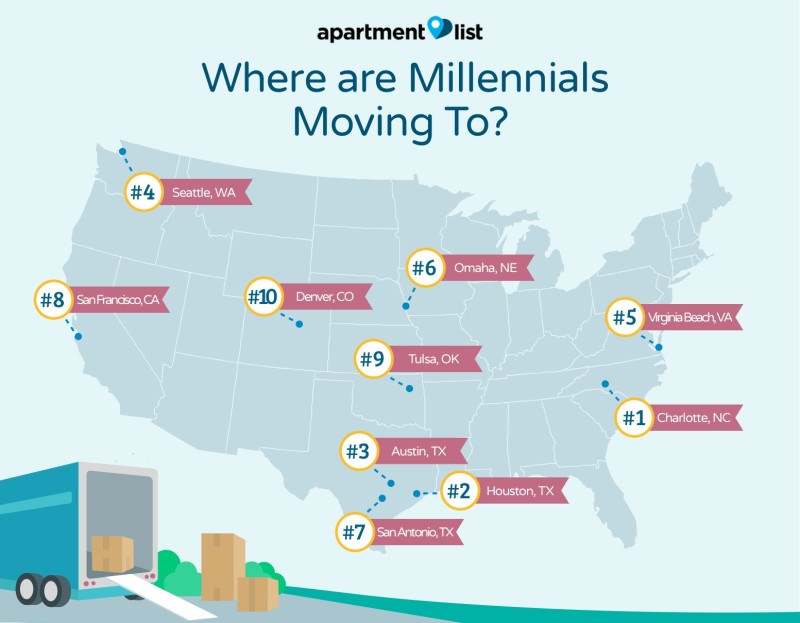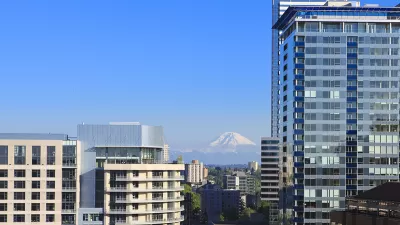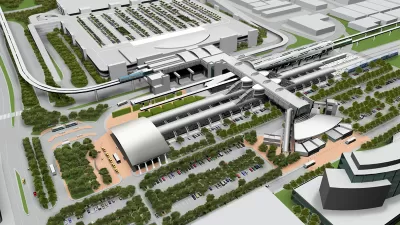Apartment List has published research showing the top destination cities for those 19 to 35 years of age based on ten years of census data from 2005-2010. Among the top 10 destinations, only three were on East and West coasts.

"Surprisingly, metropolitan areas on the interior saw the biggest increases in millennial population," writes Andrew Woo, Director of Data Science at Apartment List. "Among 50 large metropolitan areas, Charlotte, Houston, and Austin saw the most growth."
The three coastal cities to crack the top ten list were:
#4 Seattle
#5 Virginia Beach
#8 San Francisco

Courtesy of Apartment List RENTONOMICS
Woo sees this data as dispelling the notion that "millennials favor walkable cities that provide easy access to amenities and recreation." A better metric is wage growth, found in cities with strong job markets, according to his research.
The one exception is Charlotte, where population boomed even as incomes declined, but recent data suggests that incomes there are growing strongly as well.
Notwithstanding the decline of millennials in Los Angeles (more on that below), "[t]he biggest declines, however, happened in the Midwest and South – Detroit, Miami, and Phoenix, for example," adds Woo.
Millennials, those born between 1981 and 1997, are now "the largest generation in the US, numbering more than 75 million nationwide," writes Woo.
In addition to domestic migration, Woo's research also covered home ownership rates. During the time period, "millennial homeownership rate fell by 7% nationwide (from 39% to 32%), but there is significant variation across metros," he writes.
Los Angeles
In a related article for LA Weekly based on Woo's research, Dennis Romero reports that "Los Angeles is one of the American cities with the greatest declines in millennial residents from 2005 to 2015."
[Millennials] decreased by 7.4 percent over the last 10 years. The L.A. metro area, with more than 780,000 millennials, is third worst in the nation for millennial population loss, the analysis found.
Romero see's the population loss of this group as a blow to the city's plans to add urban density, expand public transit, and add bicycling facilities which "have largely been aimed at the young."
But while the county has seen overall population growth, the wave of millennial urban dwellers is weakening.
"The high cost of living combined with stagnant incomes make L.A. a relatively unaffordable place for renters," says Andrew Woo, Apartment List's director of data science. "Fewer millennials are settling in L.A."
Hat tip to Metro Transportation Headlines.
FULL STORY: Where are millennials moving to?

Planetizen Federal Action Tracker
A weekly monitor of how Trump’s orders and actions are impacting planners and planning in America.

Maui's Vacation Rental Debate Turns Ugly
Verbal attacks, misinformation campaigns and fistfights plague a high-stakes debate to convert thousands of vacation rentals into long-term housing.

San Francisco Suspends Traffic Calming Amidst Record Deaths
Citing “a challenging fiscal landscape,” the city will cease the program on the heels of 42 traffic deaths, including 24 pedestrians.

Amtrak Rolls Out New Orleans to Alabama “Mardi Gras” Train
The new service will operate morning and evening departures between Mobile and New Orleans.

The Subversive Car-Free Guide to Trump's Great American Road Trip
Car-free ways to access Chicagoland’s best tourist attractions.

San Antonio and Austin are Fusing Into one Massive Megaregion
The region spanning the two central Texas cities is growing fast, posing challenges for local infrastructure and water supplies.
Urban Design for Planners 1: Software Tools
This six-course series explores essential urban design concepts using open source software and equips planners with the tools they need to participate fully in the urban design process.
Planning for Universal Design
Learn the tools for implementing Universal Design in planning regulations.
Heyer Gruel & Associates PA
JM Goldson LLC
Custer County Colorado
City of Camden Redevelopment Agency
City of Astoria
Transportation Research & Education Center (TREC) at Portland State University
Jefferson Parish Government
Camden Redevelopment Agency
City of Claremont




























